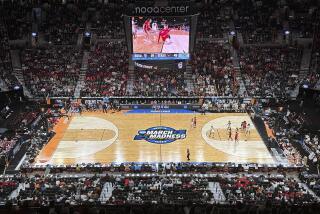‘It’s the best thing that has ever happened to the game,’ says CSUN Coach Leslie Milke : Small Basketball: Big Difference for Women?
It has been two months since four-year colleges across the nation began using a smaller ball in an experiment designed to bring new excitement to women’s basketball.
No one is quite sure how much zing the new ball has added on the court, but it is causing lots of conversation, pro and con, off the court.
Leslie Milke of Cal State Northridge and Alice Textor of Cal State Dominguez Hills are among the coaches who favor the new ball.
“I think it’s a great thing,” Milke said. “As far as I’m concerned, it’s the best thing that has ever happened to the game.”
“I was one of the coaches who consistently voted against it, but I like it now,” Textor said. “We’re a fast-breaking team with smaller players and it has really helped our game a lot.”
Ron Fortner of Pepperdine University, however, is not fond of the ball.
“I don’t see the real purpose of it,” Fortner said. “I can see it maybe improving ball handling and speeding up the game a bit, but I think it’s putting the cart before the horse.”
After the Women’s College Basketball Assn. conducted three surveys last year, the U. S. Girls and Women’s Basketball Committee, which administers rule changes for four-year colleges, voted to use the smaller ball on a one-year, experimental basis.
The committee will vote again on whether to keep the new ball in April.
High schools are also considering the smaller ball for girls. The CIF Southern Section Council is scheduled to vote this week on whether to use the ball in the 1985-86 season, and the State Federated Council will vote next month.
Dean Crowley, an administrator for the Southern Section, said there is a chance the small-ball rule will pass even if the colleges ultimately reject it.
“We surveyed our coaches and there is sentiment toward the new ball, but it wasn’t overwhelming,” Crowley said.
One high school coach in favor of the smaller ball is San Gabriel’s Bob Stand. “I think we should use the same type of ball that they use in college,” he said. “It will only help the players because I think they will be more adapted to the (small) ball when they get to college.”
Pierce College Coach Linda Gayon said that if high schools do not adopt a uniform policy, it could take college freshmen players “an entire season” to adjust to the smaller basketball.
Just how much smaller is the new ball?
It weighs between 18 and 20 ounces and has a circumference of 28 1/2 to 29 inches. That is about two ounces lighter and one inch smaller in circumference than the men’s basketball.
Most coaches and players say the most noticeable difference is weight, not size.
“If you look at the two balls they really don’t look that different,”
Milke said. “It’s the weight more than the size that makes the difference because a woman’s body strength is not as great as a man’s.”
“When you take an inch in diameter away, it’s a big thing,” added Kelly Fraser, a senior guard at Cal Poly Pomona. “I think it’s going to enable women to dunk. Eventually I think it will make the game a lot better.”
Although there has been only one dunk in the nation (by 6-7 center Georgeann Wells of West Virginia early this month) since the new ball was introduced, coaches say it has helped in other areas.
“The proponents were saying it would cut down on turnovers and add more control to the basketball, and I think it has,” Textor said.
“I like it because it has made the game faster,” USC Coach Linda Sharp said. “The passes are a lot crisper and the shooting range has increased.”
Fraser said the new ball has increased her shooting range by at least two feet.
The smaller ball also was supposed to increase shooting percentages, but most area college coaches say their shooting percentages have declined since last year.
“It may hurt shooting a bit, at least at first, because the small ball has a different shooting touch,” Fortner said. “The ball tends to bounce off the rim differently, too.”
Gayton said that while her team’s ball handling has improved, its shooting percentage has suffered.
“Now, they’re catching the ball a lot better and I think they’re ball handling has improved some,” Gayton explained. “But I don’t think it’s made that much of a difference in the shooting. They haven’t shot enough yet.”
First-year Valley College coach Jim Stephens said he would hate to see his team play with a bigger ball because “we make too make turnovers already.”
Noting that he thinks the smaller basketball is a plus for the girls’ game, Stephens added: “They have smaller hands and it makes a difference. The girls have better control dribbling, passing and finessing the ball.”
“It has really had an impact on the easy two- or three-foot shots because it is lighter and you can’t put it up on the boards with as much force,” UCLA Coach Billie Moore said.
Added Cal Poly Pomona Coach Darlene May: “From close in, your shooting is not as good because you’re throwing up a lighter basketball, but I think that will change in time. Right now the shooting percentages are a little off, but I think in the long run it’s an easier ball to handle.”
Critics of the smaller basketball complain that it will alter the game in an unnatural fashion.
“It’s not so much the size that bothers me,” Fortner said. “It’s just that I don’t think that’s how the game was meant to be played. I’m not an advocate of the shorter basket, either.”
“They’re trying to equate the men’s and the women’s game, and I think these rules are going against that,” Occidental Coach Julie Casey said.
Fortner and Casey said they think that changing the rules will not necessarily improve the quality of the game.
“This may sound chauvinistic, but in my opinion the women are never going to be as good or as fast as the men no matter what they do to the game,” Casey said.
“It’s still really difficult to palm the ball unless you have big hands, and in order to slam dunk you need to be able to jump higher.”
However, proponents of the smaller ball believe it will bring about positive changes.
“I don’t think it takes away from anything,” Textor said. “If anything, I think it’s drawing it closer to the men’s game.”
“It doesn’t hurt the game,” May said. “I think that’s a bunch of bull. You have to try to make the game the most enjoyable for everyone concerned, including the players and the fans. Who says Mr. Naismith intended the ball to be that (larger) size, anyway?”
Moore, who voted against the smaller ball last year, said the new ball deserves more than just a one-year trial.
“I don’t want to say throw the new ball away and let’s go with the old one,” she said. “We should go with it for three or four years and then let’s see.”
Dave Cater contributed to this story.
More to Read
Get our high school sports newsletter
Prep Rally is devoted to the SoCal high school sports experience, bringing you scores, stories and a behind-the-scenes look at what makes prep sports so popular.
You may occasionally receive promotional content from the Los Angeles Times.






